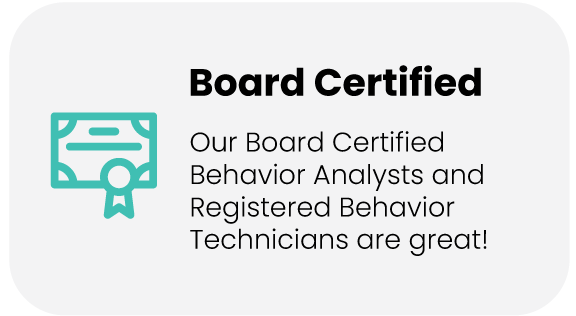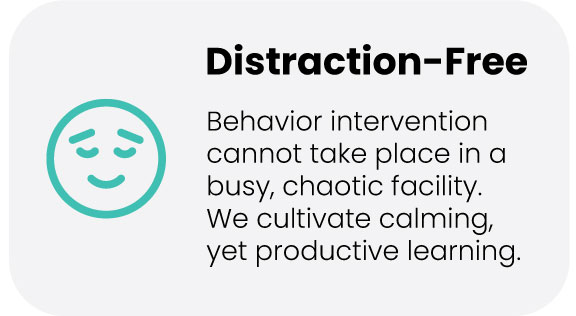Applied Behavior Analysis

The Applied Behavior Analysis approach breaks desirable behaviors down into steps and rewards the child for completing each step along the way. ABA can certainly help your child to learn new skills and partake in whatever life has to offer. ABA involves one-on-one therapy delivered by behavior therapists to help your child reach their individual goals — developing social skills, for instance, and learning to write a name or use the bathroom.



What Parents Say
“I first heard about Skylight when we got the diagnosis of autism for our daughter Piper. When she first came to Skylight she was non-verbal. But since then she has grown exponentially.”
Lindsey Graff (Client Parent)
Our Vision

The vision of Skylight Autism Center is promoting a positive change through Applied Behavior Analysis giving children a chance to lead their best quality of life.
Skylight Autism Center provides a welcoming learning environment where each child can grow and build their skills across a multitude of developmental areas for ages 2-18. Your child’s therapy program will be designed individually on the principles of Applied Behavior Analysis. The science of behavior analysis focuses on how behavior works, or how learning takes place. One of the basic principles of behavior analysis is positive reinforcement. When a behavior is followed by something that is valued (reward), that behavior will likely be repeated. Research has proven that quality ABA programs implemented 25-40 hours per week show higher overall treatment success. We can’t guarantee success, but we believe that every child deserves a chance to maximize their potential.
Take a look inside our Centers
Treatment goals may include: Communication Skills, Play and Leisure Skills, Natural Environment, Learning Social Skills, Reduction in Challenging Behaviors, Academic Skills, Family Interaction, Transition to School, Fine and Gross Motor Skills + Functional & Daily Living Skills
Experienced, supervising professionals are on staff at all times to assist treatment therapists working with your child. This can be a great asset with challenging autism symptoms and specific teaching questions that arise. Having all staff under one roof allows for on-going, regular staff oversight and training.
Each child will have an individualized therapy program in which goals are tracked and carefully modified for success. Every treatment therapist has an iPad in which data is collected through a behavioral platform software. This makes it easy to effectively track behaviors, input data and watch progress.
The center is a perfect place to acquire new skills in a distraction-free environment, that may be more challenging at home. New toys and materials keep your child motivated in a fun environment to learn.
Gradually exposing children to structured learning, in a small group of peers will allow them to be more comfortable and successful in a larger group setting preparing your child for school and gaining important social skills.
Why Early Intervention?

Autism experts agree that intervention should begin early. The intervention should be designed to fit the child rather than forcing the child into a specific model. That’s where Applied Behavior Analysis (ABA) is the best choice for early autism intervention. With structured teaching, on a one-to-one basis, in which children are rewarded for achieving certain goals, such as learning to look people in the eye or using a word to ask for an item instead of crying. Rewards range from M&Ms to a few minutes of playtime with a treasured toy. You want a certain behavior, so you give the child a couple of chances and then you reward the positive behavior.
Record-keeping is crucial to the program. Therapists maintain detailed notes on everything from how long it took the child to exhibit the behavior to how long until he exhibits it with 80% reliability. Various aspects of both behavioral and developmental approaches can be combined with each other and/or with speech, occupational, physical, and social development therapies. The average age of diagnosis for autism is 6, even though the American Academy of Pediatrics recommends that all 18- and 24-month-olds be screened for ASD and other developmental delays. Later diagnosis doesn’t preclude treatment and progress. But the reality is that the earlier they start, the better.

Why Early Intervention?
Many more boys are diagnosed with autism every year than girls. According to the Centers for Disease Control and Prevention, the disorder is 4.5x more common for boys to be diagnosed than girls. That’s because the symptoms of autism are often less obvious in girls than they are in boys. Girls can be better at blending in or masking symptoms. Girls with autism may score the same on indicators of friendship or empathy as boys, but not the same as typically-developing girls.
- Poor eye contact
- Passive in social interactions
- Little facial expression, smiling, and/or emotional control when interacting with others
- Delayed babbling, infrequent vocalization, and decreased object manipulation
- Abnormal movements, little variety of movement in exploring new objects, poor muscle tone and motor coordination
- Infrequent or delayed response when name is called
- Infrequent monitoring of the direction of other’s gaze
- Infrequent response to others’ pointing gestures
- Infrequent attempts to point out or show objects of interest
- Infrequent smiling at others paired with eye contact
- Low variety of speech sounds and gestures during communication attempts
- Delayed language development
- Low variety of actions on toys
- Infrequent vocalization paired with eye contact
- Repetitive behaviors and interests
- Unusual sensory responses, such as being unable to tolerate the feel of grass on bare feet
- Infrequent imitation of others’ actions
- Minimal display of interest in other children
- Infrequent attempts to share with others
- Limited range of facial expression
- Infrequent offering of comfort to others
- Aggressive behavior towards others
- Self-harm
- Low variety of words produced
- Repetitive behaviors
- Restricted interests
- Unusual sensory responses

Wisconsin Children with Autism
Despite developmental concerns noted in many of the children’s records by 3 years of age throughout Wisconsin, only 48.1% of children identified with ASD (Autism Spectrum Disorder) received a comprehensive developmental evaluation by age 3 years. An even fewer percentage started Applied Behavior Analysis. We’re here to change that!

